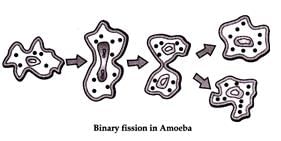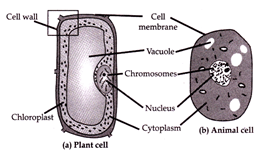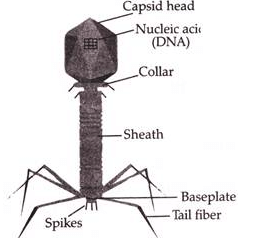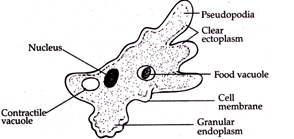Class 8 Science: Sample Question Paper - 6 | Science Class 8 PDF Download
Ques 1: Choose the correct options:
(i) Sulphurous acid turns blue litmus paper into:
(A) Blue
(B) Red
(C) Neutral
(D) No reaction
Ans: B
Ques 2: Choose the correct options:
(ii) Petroleum was formed from organisms:
(A) Living on the land
(B) Living in the sea
(C) Living on the plants
(D) Living on the rocks
Ans: B
Ques 3: Choose the correct options:
(iii) In villages, people use wood as fuel because
(A) it is considered to be an ideal fuel
(B) of its easy availability and low cost.
(C) it is environment friendly.
(D) it catches fire easily.
Ans: B
Ques 4: Choose the correct options:
(iv) What do black buck, elephant, python and golden cat together represent in a forest?
(A) fauna
(B) ecosystem
(C) flora
(D) species
Ans: A
Ques 5: Choose the correct options:
(v) Which one of the following terms is not a part of the nucleus?
(A) ribosomes
(B) chromosomes
(C) nucleolus
(D) cytoplasm
Ans: A
Ques 6: Choose the correct options:
(vi) Reproduction by budding takes place in
(A) hydra
(B) amoeba
(C) paramecium
(D) bacteria
Ans: A
Ques 7: Choose the correct options:
(vii) For the metamorphosis of tadpoles; which of the following elements must be available in water?
(A) Chlorine
(B) Carbon
(C) Sulphur
(D) Iodine
Ans: D
Ques 8: Choose the correct options:
(viii) Which one of the following forces is a contact force?
(A) force of gravity
(B) force of friction
(C) magnetic force
(D) electrostatic force
Ans: B
Ques 9: Choose the correct options:
(ix) To sharpen the blade of a knife by rubbing it against a surface, which of the following will be most suitable?
(A) Stone
(B) Plastic block
(C) Wooden block
(D) Glass block
Ans: C
Ques 10: Choose the correct options:
(x) An electric current can produce
(A) heating effect only
(B) chemical effect only
(C) magnetic effect
(D) chemical, heating and magnetic effect
Ans: D
Ques 11: (i) "Cells are the basic structural units of living organisms." Explain.
Ans: (i) Organisms in the living world differ from one another but all are made up of cells. So, cells in the living organisms are basic complex living structures.
Ques 12: (ii) What is the purpose of tail in the sperm?
Ans: (ii) The sperms swim in the oviduct with the help of their tails to reach the egg.
Ques 13: (iii) Which force is responsible for wearing out tyres of motor vehicles?
Ans: (iii) Tyres of motor vehicles wear out due to frictional force between tyres and the road.
Ques 14: (iv) What is a drag?
Ans: (iv) The frictional force exerted by fluids is called drag.
Ques 15: (v) What is ultrasound?
Ans: (v) Sound frequencies higher than 20,000 Hz are called ultrasound.
Ques 16: (vi) Explain why a layer of zinc is coated over iron.
Ans: (vi) Layer of zinc is coated over iron because zinc prevents it from rust and corrosion.
Ques 17: Write any three positive characteristics of plastic.
Ans: Plastic is very strong/ light and durable. It can be moulded into different shapes and sizes. It is used for various purposes. Plastics are generally cheaper than metals. They are widely used in industry and for household articles.
Ques 18: Give reason:
(i) Sulphuric acid is poured on copper plate.
(ii) Write word equation of the reaction involved.
Ans: (i) Copper plate reacts with sulphuric acid and forms copper sulphate and hydrogen gas and a blue colour of copper sulphate appears.
(ii)
Ques 19: It is difficult to burn a heap of green leaves but dry leaves catch fire easily. Explain.
Ans: As dry leaves have low ignition temperature than heap of green leaves because green leaves have water and other elements in them. So to ignite the green leaves/ we have to heat them up to ignition temperature of their constituents which is comparatively high. So/ it is easier to ignite dry leaves than green leaves.
Ques 20: Explain how deforestation leads to reduced rainfall.
Ans: The plants need carbon dioxide for photosynthesis. Fewer trees would mean less consumption of carbon dioxide and its increased amount in the atmosphere. This leads to global warming as carbon dioxide traps the heat of sun rays. The increase in temperature on earth disturbs the water cycle and reduces rainfall. This causes drought.
Ques 21: Draw binary fission in Amoeba.
Ans: 
Ques 22: Name the virus that causes AIDS. What are the mediums through which this virus is transmitted?
Ans: AIDS is caused by a virus named HIV. It can be transmitted from an infected person to a healthy person by following ways:
(i) By infected syringes.
(ii) By infected mother to an infant.
(iii) By sexual contact with infected person.
Ques 23: An astronaut travels from the earth to the moon. How do its weight and mass change?
Ans: Mass of an object remains constant at all the places, so mass of astronaut will not change. Weight of an object depends upon the gravity and at the moon, gravity is lesser than earth, so weight of astronaut will decrease.
Ques 24: What is the cause of friction?
Ans: Friction is caused by the irregularities on the two surfaces in contact. Even those surfaces that appear smooth have a large number of irregularity which lock each surface into one another.
Ques 25: Compare the sound of drum and whistle.
Ans: The frequency determines the shrillness or pitch of a sound. A drum vibrates with low frequency. Therefore, it produces low pitched sound. Whistle has a high frequency and therefore, produces a sound of higher pitch.
Ques 26: Why do we not hear the sound of an explosion on the surface of the moon?
Ans: There is no atmosphere on the moon and sound waves need .a medium to travel. So we cannot hear the sound on the moon.
Ques 27: Give reason:
Water is not used to control the fire involving electrical appliances or equipment.
Ans: In case of fire produced by electric short circuit or electric equipment, water is not used at all because water is a good conductor of electricity and may result in electrocution or electric shock.
Ques 28: Once in a village, there was a fire in a hut. When a lot of dry powder of a substance, A was released over the fire, the fire got extinguished.
(i) Name the substance A.
(ii) How does the substance extinguished fire?
(iii) Give another substance which behaves like substance A.
Ans: (i) A is sodium bi-carbonate (NaHCO3).
(ii) The heat of fire decomposes sodium bicarbonate to produce carbon dioxide gas which covers the fire like a blanket. It cuts off supply of fresh air to the burning substance. Thus, fire gets extinguished.
(iii) Potassium hydrogels
Ques 29: Draw a sketch of animal cell and plant cell showing differences between them.
Ans: 
Ques 30: Give reason.
Sportsmen use shoes with spikes.
Ans: Sportsmen use shoes with spikes because these shoes give them a better grip while running. This is because the force of friction between the shoes and the ground increases with the help of spikes.
Ques 31: What are three main factors essential to maintain reproductive health? Explain their importance.
Ans: Three main factors essential to maintain reproductive health are:
(i) Balanced Diet: The diet which contains the correct amount of each constituent (such as carbohydrates, fats, proteins, vitamins, minerals) sufficient for normal growth and development of a body.
(ii) Personal hygiene: Adolescent boys and girls should take bath regularly, because the increased activity of sweat and oil glands can cause bacterial infection, if not washed and cleaned every day.
(iii) Physical exercise for adolescence: Adolescent girls and boys should regularly do exercise as they improve mental health and protects the person from any disease or fatigue and increases the efficiency of the person.
Ques 32: Draw structure of virus and amoeba.
Ans: Virus:
Amoeba:
Ques 33: Corrosion is a serious problem. Every year an enormous amount of money is spent to replace damaged iron. What steps can be taken to prevent this damage?
Ans: The wasting of iron objects due to rusting causes a big loss to the country's economy/ so it must be prevented by following methods:
(i) By painting: Paint is applied to the surface of an iron object, then air and moisture cannot come in contact of iron and hence no rusting occurs.
(ii) By applying grease or oil: Tools and machine parts made of iron and steel are smeared with grease or oil to prevent their rusting.
(iii) By galvanization: Galvanization is done by dipping an iron object in molten zinc metal. This thin layer of zinc metal on the surface of iron objects protects them from rusting.
(iv) By tin plating and chromium-plating: When a thin layer of tin metal is deposited on iron and steel objects by electroplating then the iron and steel objects are protected from rusting.
(v) By allowing it to make stainless steel: When iron is alloyed with chromium and nickel, stainless steel is obtained/ which does not rust at all.
Ques 34: What are food preservatives? Explain some common food preservatives.
Ans: The chemical substances which are used to check or stop the growth of harmful micro-organisms in food are called food preservatives. These food preservatives keep the edible food materials protected from the invasion of micro-organisms which can spoil the food.
Some common food preservatives are:
(i) Salt: Common salt is used to preserve meat, fish, ambia, raw mangoes, tamarind, etc.
(ii) Sugar: Jams, jellies and squashes are preserved by sugar. Sugar reduces the moisture content which inhibits the growth of bacteria that can spoil food.
(iii) Oil: Edible oils are used as preservatives in vegetables and pickles. Oil does not allow the moisture to surface, thus preventing the growth of harmful bacteria.
(iv) Vinegar: It is used to preserve fruits, vegetables, fish, meat and pickles.
Ques 35: What are the major groups of micro-organisms?
Ans: Micro-organisms are divided into four major groups which are as follows:
(i) Bacteria: These are single celled organisms which are harmful, as they cause disease and some of them may be useful as in vaccines.
(ii) Fungi: These are non-green plants which consume their food from the dead organic matter.
(iii) Protozoan: These are unicellular animals which cause diseases like malaria and dysentery.
(iv) Algae: These are photoautotrophic organisms that may be unicellular or multicellular.
They play important role in medicines, agriculture, industry and as food.
Viruses are also considered to be micro-organisms but are actually the connecting links between non-living and living organisms.
Ques 36: Explain how fertilizers are different from manures?
Ans: Fertilizers differ from manures in following ways:
(i) Manures are organic substances while fertilizers are chemical substances.
(ii) Manures are prepared in fields, while fertilizers are prepared in factories.
(iii) Manures contain all the nutrients, while fertilizers are rich in certain nutrients.
(iv) Manures provide humus, while fertilizers do not provide it.
|
92 videos|296 docs|44 tests
|





















